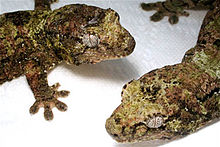- Rhacodactylus chahoua
-
Mossy New Caledonian gecko 
Prehensile-Tail Mossy Gecko, Rhacodactylus chahoua Scientific classification Kingdom: Animalia Phylum: Chordata Class: Reptilia Order: Squamata Family: Gekkonidae Genus: Rhacodactylus Species: R. chahoua Binomial name Rhacodactylus chahoua
Bavay, 1869Rhacodactylus chahoua commonly known as the Mossy New Caledonian gecko or Short-snouted New Caledonian gecko, is an arboreal gecko found natively on the southern portion of the island of New Caledonia and on the outlying islands of Ile de Pines and Grande Terre. R. chahoua is currently being evaluated by CITES as a possible candidate for protective status. R. chahoua was first described by Bavay in 1869.
R. chahoua gets its common name from the moss or lichen-like pattern it displays. Colors range from rusty red and brown to green or gray. There has been some notation that color could possibly be a geographic indicator in this species as the geckos from the outer islands most often display the lighter gray patterns. It commonly reaches a snout to vent length (SVL) of 5.5 inches.
R. chahoua, like all of the Rhacodactylus geckos are omnivores. Their diet in the wild consists of various insects and fruits. They may also consume small lizards as part of their diet.
R. chahoua lays two well calcified eggs that become adhered to one another shortly after laying. This is known as "egg gluing". R. chahoua is the only Rhacodactylus gecko that lays adhering eggs. The eggs are generally laid on top of the substrate (generally behind loose tree bark) and are guarded by the female. The eggs hatch 60-90 days after laying.
This gecko is seen in the herpetology trade but rarely. A male-female pair may be kept in a terrarium with a minimum size of 24x18x18, but as with all arboreal geckos, the taller the better.
Categories:- Reptiles of New Caledonia
- Gekkonidae
Wikimedia Foundation. 2010.
